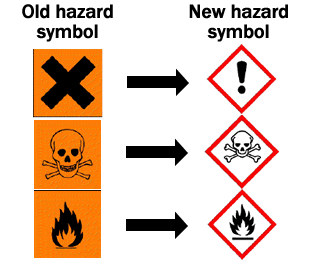 Go to main content
Go to main content
Archive Website of the UK government
Please note that this website has a UK government accesskeys system.
Main menu
Page menu
Home and community

Chemical safety in the home

Chemicals used in the home every day, for example for cleaning, can sometimes be harmful if not used in the right way. Find out how to recognise chemical products that could harm you and how to store, use and dispose of them safely.
Chemical products in the home
Most people use chemicals at home every day. Cleaning products like bleach, oven sprays and toilet cleaners are chemicals. So are paints, glues, oils, pesticides and medicines.
Most of the chemicals you use at home aren’t dangerous if you use them properly. However, some chemicals need more careful handling than others.
Labels can help you identify the more hazardous chemicals, tell you what the dangers are and advise how to use chemicals safely.
How to recognise chemicals that could harm you
Most chemical products carry hazard symbols telling you whether a substance is harmful and in what way. You might see one or more symbols on a single product.
These symbols are in the process of changing, so it’s possible you will see some new hazard symbols. Some of the most common hazard symbols are:

Irritant / harmful (top symbol)
For example, causes irritation or can harm you if swallowed, inhaled and/or in contact with skin
Toxic (middle symbol)
For example, poisonous if swallowed, inhaled and/or in contact with skin
Flammable (bottom symbol)
For example, easily catches fire
Chemical products will also usually have information about safely using the product – it’s important to read and follow this advice. Sometimes, labels will give details of the supplier so you can get further advice.
Medicines are specialist chemicals. They won’t carry the symbols above, but can be harmful if taken in the wrong quantities or by children.
Using hazardous chemical products safely
To stay safe when using potentially harmful products in the home, always read the warning label and follow the instructions.
In addition, with many chemicals, it’s advisable to follow these guidelines:
- only use as much as you need of a product
- if a substance is hazardous, remove children, pets and their toys from the area for as long as is recommended on the label
- properly ventilate the area by opening the windows – if recommended, wear gloves, long sleeves and a mask
- don't leave chemical products unattended – if you have to leave the room in the middle of a task, put the product away or take it with you
- it’s dangerous to combine two common household cleaners, chlorine bleach and ammonia, as this forms a highly toxic gas
- after using chemicals, wash any part of you that came into direct contact with the substance with warm soapy water
Storing and disposing of chemical products safely
Safely store chemicals by following the storage instructions on the label.
In addition, in most cases, you should:
- not move products into other containers – these containers might not be capable of safely storing the substance, you might not remember what is in the bottle and children might mistakenly think the substance is safe
- keep all hazardous chemicals out of the reach of young children or locked up
- never store hazardous chemicals near food or food products
- keep hazardous chemicals away from items used to prepare and cook foods, like pots, pans and cooking utensils
If a product is leaking, expired or looks bad, you should dispose of it. Never pour products down the drain unnecessarily – remember that your drainage ends up in seas and rivers. Instead:
- follow the advice on the label
- take it to your local civic amenity site (waste and recycling centre), who can get rid of it safely
Your council can tell you the location and opening times of your local site.
If you have an accident with a dangerous substance
If you or a member of your family swallow or come into contact with a potentially hazardous chemical, you must seek medical attention.
You can search for medical services, including accident and emergency, on the NHS Choices website. You can also telephone the NHS 24-hour advice helpline, NHS Direct, on 0845 4647.
Provide a full description of the product and describe any symbols or guidance from the manufacturer detailed on the bottle or package.
 Facebook
Facebook Twitter
Twitter StumbleUpon
StumbleUpon Delicious
Delicious Reddit
Reddit
